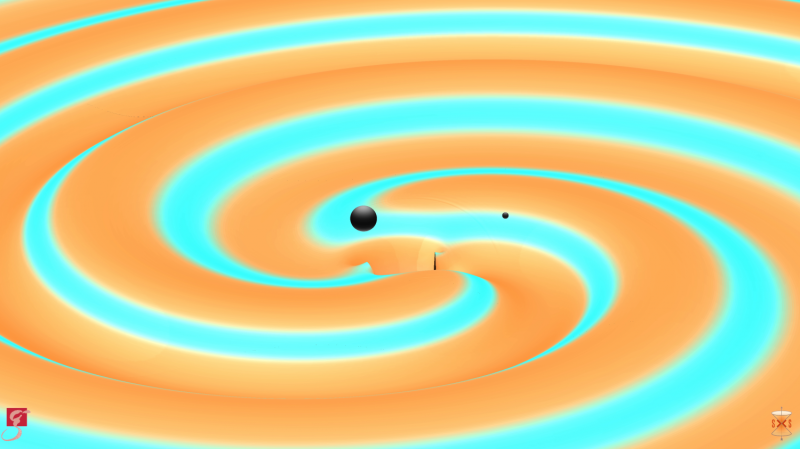Gravitational waves detected from second pair of colliding black holes

On December 26, 2015 at 03:38:53 UTC, scientists observed gravitational waves—ripples in the fabric of spacetime—for the second time.
The gravitational waves were detected by both of the twin Laser Interferometer Gravitational-Wave Observatory (LIGO) detectors, located in Livingston, Louisiana, and Hanford, Washington, USA.
The LIGO Observatories are funded by the National Science Foundation (NSF), and were conceived, built, and are operated by Caltech and MIT. The discovery, accepted for publication in the journal Physical Review Letters, was made by the LIGO Scientific Collaboration (which includes the GEO Collaboration and the Australian Consortium for Interferometric Gravitational Astronomy) and the Virgo Collaboration using data from the two LIGO detectors.
Gravitational waves carry information about their origins and about the nature of gravity that cannot otherwise be obtained, and physicists have concluded that these gravitational waves were produced during the final moments of the merger of two black holes—14 and 8 times the mass of the sun—to produce a single, more massive spinning black hole that is 21 times the mass of the sun.
"It is very significant that these black holes were much less massive than those observed in the first detection," says Gabriela González, LIGO Scientific Collaboration (LSC) spokesperson and professor of physics and astronomy at Louisiana State University. "Because of their lighter masses compared to the first detection, they spent more time—about one second—in the sensitive band of the detectors. It is a promising start to mapping the populations of black holes in our universe."
During the merger, which occurred approximately 1.4 billion years ago, a quantity of energy roughly equivalent to the mass of the sun was converted into gravitational waves. The detected signal comes from the last 27 orbits of the black holes before their merger. Based on the arrival time of the signals—with the Livingston detector measuring the waves 1.1 milliseconds before the Hanford detector—the position of the source in the sky can be roughly determined.
"In the near future, Virgo, the European interferometer, will join a growing network of gravitational wave detectors, which work together with ground-based telescopes that follow-up on the signals," notes Fulvio Ricci, the Virgo Collaboration spokesperson, a physicist at Istituto Nazionale di Nucleare (INFN) and professor at Sapienza University of Rome. "The three interferometers together will permit a far better localization in the sky of the signals."
The first detection of gravitational waves, announced on February 11, 2016, was a milestone in physics and astronomy; it confirmed a major prediction of Albert Einstein's 1915 general theory of relativity, and marked the beginning of the new field of gravitational-wave astronomy.
The second discovery "has truly put the 'O' for Observatory in LIGO," says Caltech's Albert Lazzarini, deputy director of the LIGO Laboratory. "With detections of two strong events in the four months of our first observing run, we can begin to make predictions about how often we might be hearing gravitational waves in the future. LIGO is bringing us a new way to observe some of the darkest yet most energetic events in our universe."
"We are starting to get a glimpse of the kind of new astrophysical information that can only come from gravitational wave detectors," says MIT's David Shoemaker, who led the Advanced LIGO detector construction program.
Both discoveries were made possible by the enhanced capabilities of Advanced LIGO, a major upgrade that increases the sensitivity of the instruments compared to the first generation LIGO detectors, enabling a large increase in the volume of the universe probed
"With the advent of Advanced LIGO, we anticipated researchers would eventually succeed at detecting unexpected phenomena, but these two detections thus far have surpassed our expectations," says NSF Director France A. Córdova. "NSF's 40-year investment in this foundational research is already yielding new information about the nature of the dark universe."
Advanced LIGO's next data-taking run will begin this fall. By then, further improvements in detector sensitivity are expected to allow LIGO to reach as much as 1.5 to 2 times more of the volume of the universe. The Virgo detector is expected to join in the latter half of the upcoming observing run.
LIGO research is carried out by the LIGO Scientific Collaboration (LSC), a group of more than 1,000 scientists from universities around the United States and in 14 other countries. More than 90 universities and research institutes in the LSC develop detector technology and analyze data; approximately 250 students are strong contributing members of the collaboration. The LSC detector network includes the LIGO interferometers and the GEO600 detector.
Virgo research is carried out by the Virgo Collaboration, consisting of more than 250 physicists and engineers belonging to 19 different European research groups: 6 from Centre National de la Recherche Scientifique (CNRS) in France; 8 from the Istituto Nazionale di Fisica Nucleare (INFN) in Italy; 2 in The Netherlands with Nikhef; the MTA Wigner RCP in Hungary; the POLGRAW group in Poland and the European Gravitational Observatory (EGO), the laboratory hosting the Virgo detector near Pisa in Italy.
More information: The research paper, "GW151226: Observation of Gravitational Waves from a 22 Solar-mass Binary Black Hole Coalescence," by the LIGO Scientific Collaboration and the Virgo Collaboration, has been accepted for publication in the journal Physical Review Letters.
Journal information: Physical Review Letters
Provided by Massachusetts Institute of Technology



















